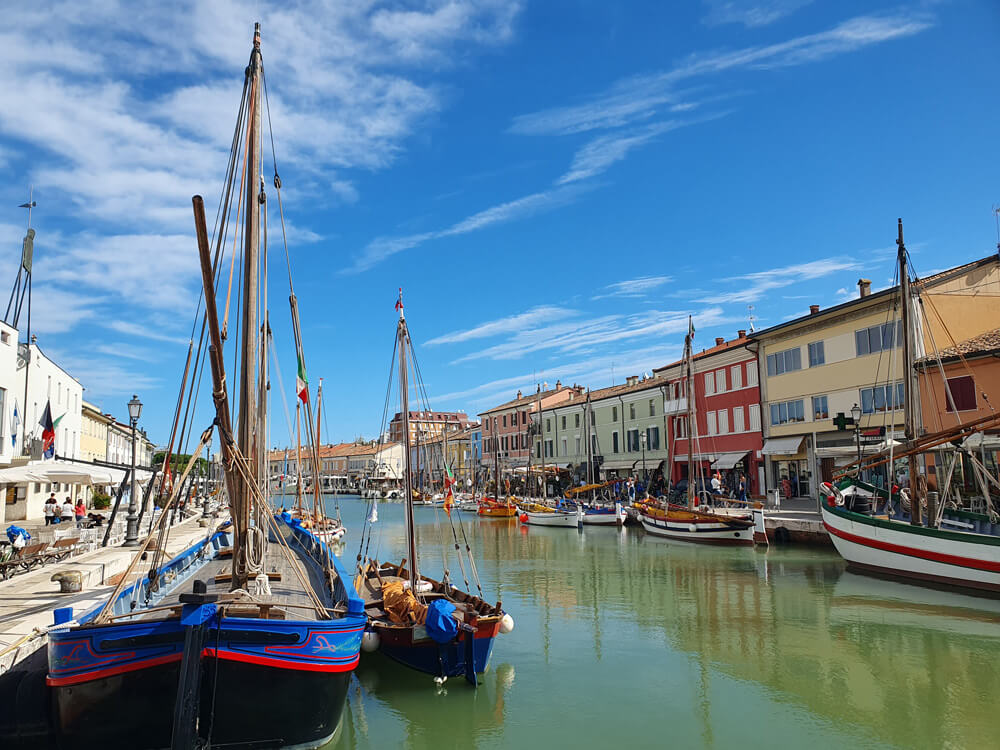Cesenatico (pronounced ChezenAticko) is a delightful seaside resort with a long sandy beach on Italy’s Adriatic coast, in the Emilia-Romagna region. The small town has a charming historic centre along a picturesque canal lined with traditional fishing boats, as well as a more modern district by the sea. If you’re looking for a destination with some enjoyable contrasts and a bit more to do when you’re not on the beach, Cesenatico is a good choice for a holiday or short break.
Located on a coastal railway line between Ravenna and Rimini, Cesenatico’s good public transport connections makes it easy to enjoy day trips to or from the town, or to include the resort on a car-free touring holiday.
In this article you’ll find a guide to what to see and do in Cesenatico, where to stay, some historical background and context and my own impressions and advice after visiting the town (which I loved). If you find this helpful, please ‘buy me a coffee‘ or consider using my accommodation-booking links below, which support the website. Thank you. Enjoy!
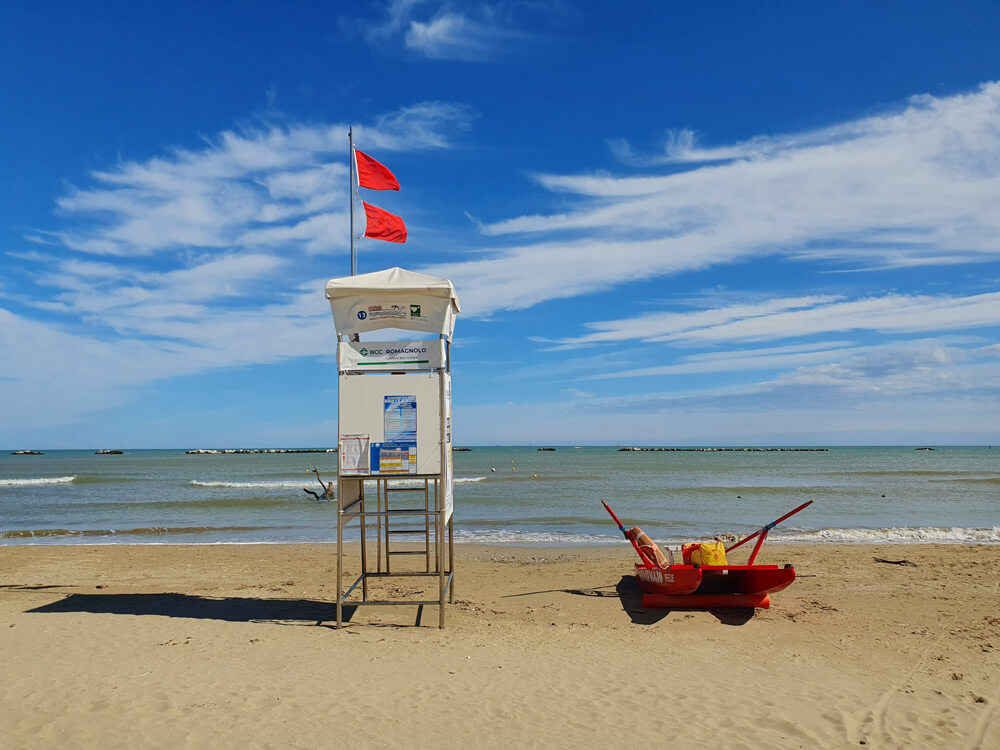
Why to visit Cesenatico
- Delightful sandy beach and civilised seaside charms
- Attractive and unusual historic centre around a picturesque canal; heaps of character
- Enticing canalside restaurants and bars in this foodie region
- Excellent small maritime museum and historic boats
- Rail connection to other Emilia-Romagna destinations
Cesenatico: What to do and see
Cesenatico has several very interesting sights to see as well as pleasant lanes and canalside to explore, and seaside activities to enjoy. There’s an excellent maritime and local history museum in the historic centre, plus a couple of small museums dedicated to notable local figures. I describe these in more detail further down this page.
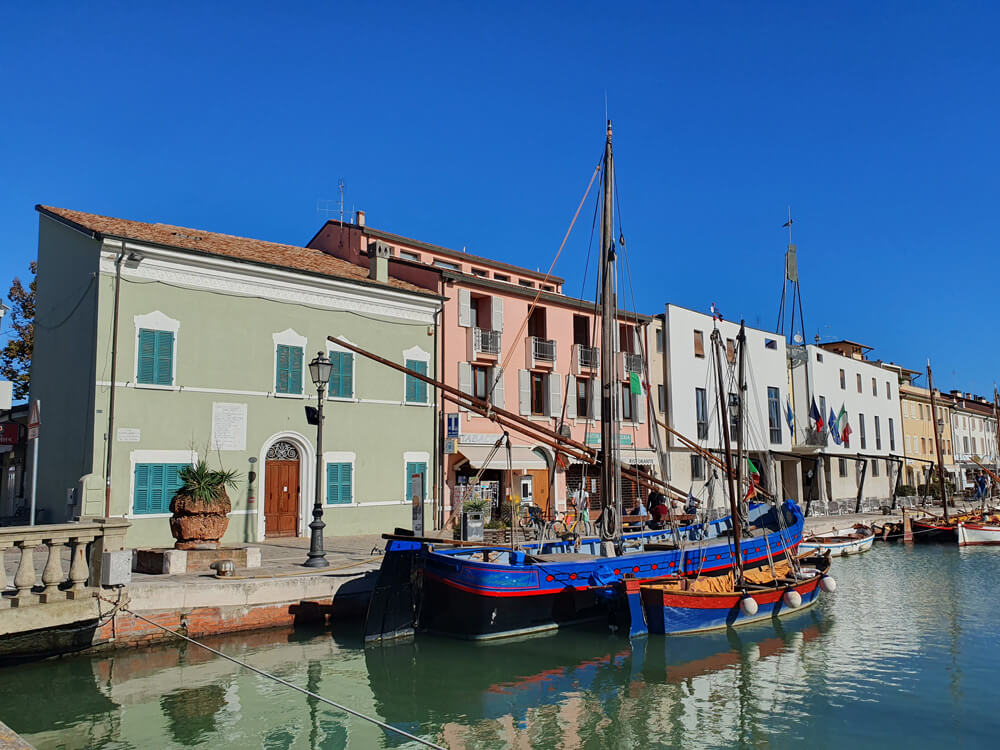
Some background
Like some of Italy’s other most appealing seaside resorts, Cesenatico is a destination of two halves. It grew up as the port for the nearby inland town of Cesena. The historic centre (centro storico) is a picturesque fishing port divided in two by a wide sea-bound canal, the Porto Canale. Cesenatico’s fishing heritage is still alive today. Beyond the historic boats moored along the canal are modern fishing vessels which still ply their trade at sea. Between the old town and the Adriatic there is a port to the north of the canal and a second, shorter canal running south, where pleasure boats are moored.
The ‘second’ Cesenatico is the modern beach resort which has grown up since the late 19th century along the coast. This spreads north and south along sandy beaches. Here you’ll find most of the town’s hotels and apartment blocks, along wide straight streets. There are everyday services here, and the usual range of tourist and seaside shops and businesses. Cesenatico has a resident population of 26,000, and 22,000 hotel beds, illustrating the importance of summer holiday tourism to the local economy.
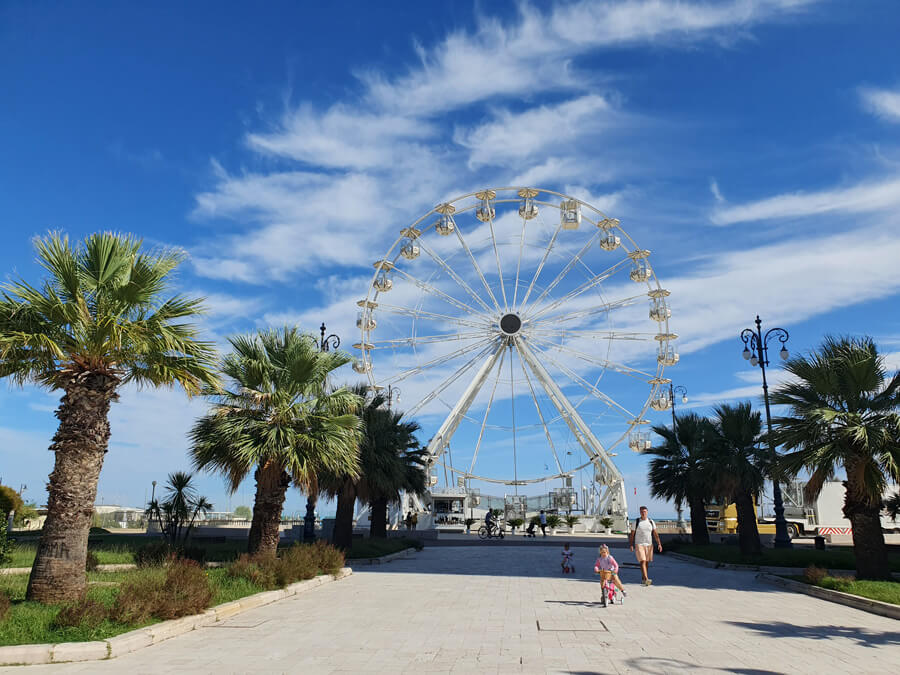
Two names from Italian history you will encounter around Cesenatico, though neither individual spent more than a few hours here, are Leonardo da Vinci and Giuseppe Garibaldi. It is now part of local folklore that Leonardo ‘designed’ the Porto Canale. As explained in the (admirably honest) museum, this isn’t actually true. Leonardo did indeed visit in 1502, on a mission to survey and report on the local fortifications and waterways for his employer Cesare Borgia. Copies of his drawings of Cesenatico are displayed in the Antiquarium. The canal had already existed for a long time at that point, though. The idea of attributing it to Leonardo was fostered in the 20th century to promote tourism.
Cesenatico’s Garibaldi connection is a poignant one. On his retreat from Rome towards Venice, on 2nd August 1849, Garibaldi, his wife Anita and other patriots reached Cesenatico. They arrived at midnight, and within hours they had commandeered a small fleet of thirteen fishing boats and provisions, and set sail. They never made it to Venice. Anita Garibaldi was pregnant and seriously ill and died two days later just north of here, near the Comacchio lagoon, after their boats were spotted and attacked by the Austrian navy. There’s a monument to Garibaldi and Anita by the canal in Piazza Ciceruacchio, as well as the standard Garibaldi statue on a plinth in Piazza Pisacane. The town holds a historic festival each August to commemorate the embarkation.
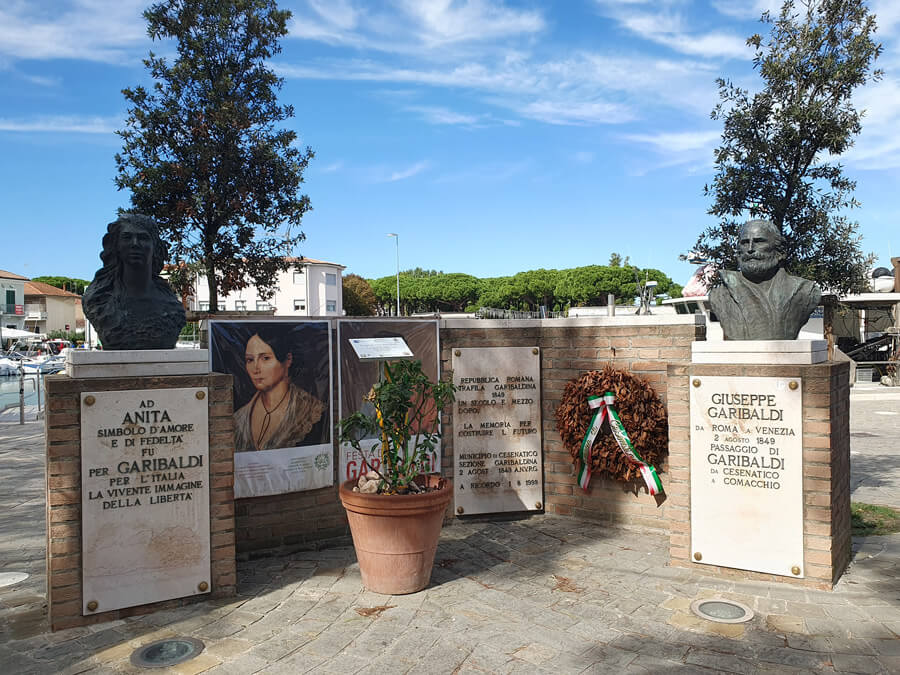
Where to begin
Cesenatico’s tourist information office, near the sea on Viale Roma, is a good place to start your visit. You’ll find useful maps, suggested walking tours and other information in English. The official tourism website is helpful too: https://visitcesenatico.it/en/
When discovering Cesenatico, you soon grasp the extent to which the town is divided in two by its famous canal. There are two bridges crossing the waterway in the inland half of the centro storico. Between these and the sea, however, there are no more bridges as crossing points. The canal is still kept navigable for the boats which head out to sea each day. Instead Cesenatico has two quaint little foot ferries which provide a means of crossing the canal. One, the Traghetto Mirko, is at the seaward edge of the centro storico. The second is the Traghetto Giovanna d’Arco, crossing further out towards the mouth of the canal. There’s a small fee for using these; their operating hours are seasonal.
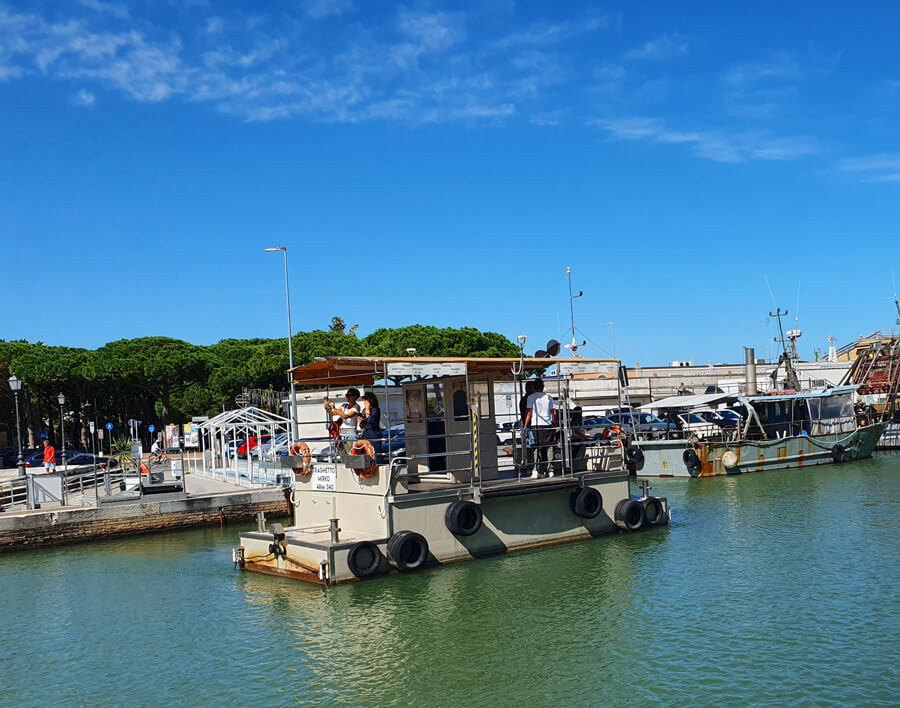
Museo della Marineria
The Museo della Marineria, Cesenatico’s maritime museum, is the town’s top tourist attraction. This is an excellent small museum with an unusual feature: it has a ‘floating section’. A collection of historic local boats are permanently moored in the canal outside as an open-air exhibit, viewable from the canalsides. Past the last bridge in the direction of the sea is a huge array of further small, privately-owned traditional vessels moored along the canal. If you visit on a fine day when all these boats have their traditional red and yellow sails raised, it must be a spectacular sight.
The museum building is purpose-built to show off its largest exhibits, two historic boats, a trabaccolo (fishing lugger) and a bragozzo, a traditional boat-type used around this part of Italy and particularly associated with the Venetian lagoon. Cesenatico has historic ties with Chioggia, a similar canal and fishing town at the southern end of the Venetian lagoon, north of here, and you’ll encounter several examples of shared history and seafaring traditions.
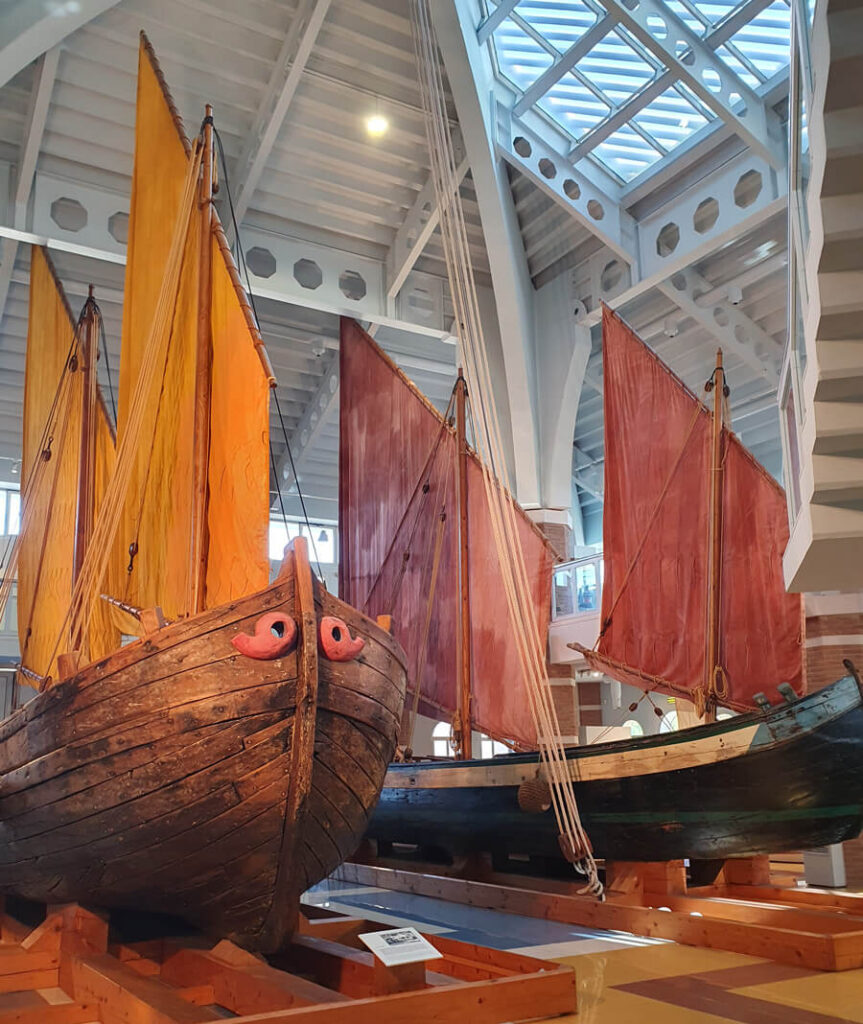
Around these two restored vessels are displays dedicated to different aspects of boat construction and the history of the local fishing industry. The exhibits, which visitors are invited to touch as well as look at, are well-presented and almost all the informative descriptions include good English translations. As well as the exhibits themselves, I was impressed by the contextual information and thought-provoking insights provided.
The nautical and fishing theme continues upstairs in a gallery around the open central space. Exhibits include sailor’s chests, reminiscences from mariners (Italian-language videos) and accounts of various aspects of Cesenatico’s maritime history including the life ashore for women. One particularly curious object is a small wooden boat-shaped object pierced with holes called a marotta. This was designed to float half-submerged in the canal to conserve live fish or eels kept inside.
The long history of Adriatic and Mediterranean seafaring and trade routes is referenced in several displays here. The heritage and symbolism of traditional decorative details on boats, like painted eyes, are among the fascinating subjects touched upon.
Cesenatico is still a fishing port today, but the museum also covers the development of the town as a seaside resort. Starting in the mid-late 19th century, this provided a whole new purpose and source of income for the town and its people.
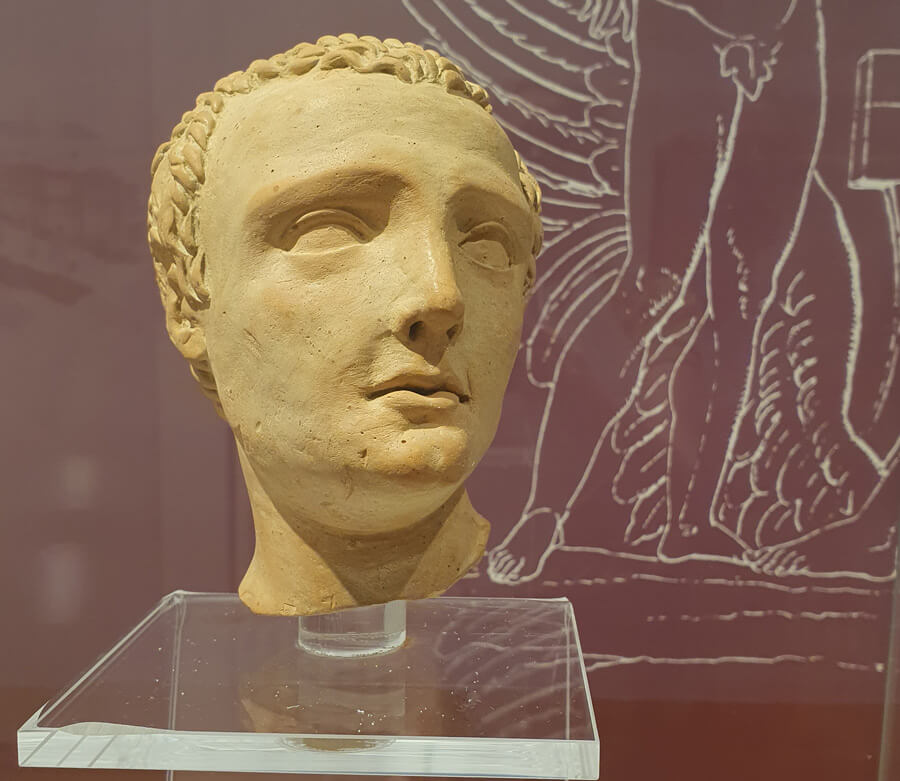
In an adjacent building, accessed via an internal corridor and included in the ticket, is another local museum. Here you’ll find the town Antiquarium, with displays of Roman-era finds from local archaeological sites. These include a damaged little terracotta figurine of a gladiator and fragments of statues speculatively identified as Daedalus and Icarus.
Local history covered here includes the town’s Leonardo and Garibaldi connections. Visitors can also read the story of a 16th-century defensive tower shelled by the British navy during the Napoleonic Wars. One display reminds the visitor that only a few decades before the development of Adriatic tourist resorts, these beaches were still facing attacks by pirate/corsair kidnappers.
Other museums and sights in Cesenatico
Included, at the time of writing, on the same admission ticket as the Museo della Marineria is the Casa Moretti (Casa Museo Marino Moretti). This house-museum and study centre is devoted to local author and poet Marino Moretti (1885-1979) who bequeathed his canalside dwelling to the town.
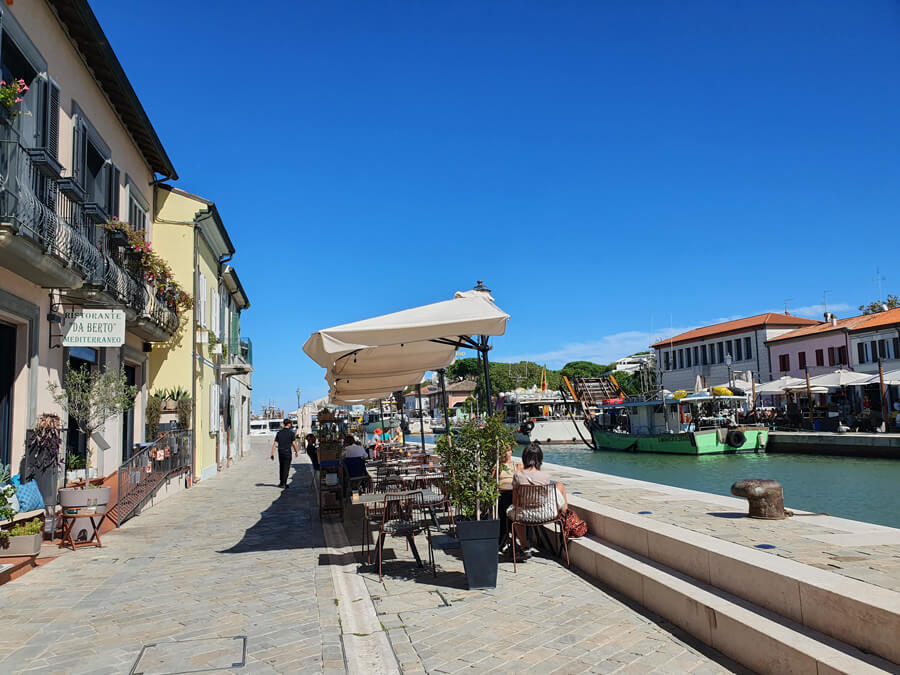
The Galleria Leonardo Da Vinci is the town art gallery, an exhibition space created from a former fish market in a little piazza towards the seaward end of the Porto Canale. Close by is the Biblioteca Comunale, Cesenatico’s public library, which is located in an imposing 1930s building from Italy’s Fascist era.
When exploring the charming lanes of the historic centre, you mustn’t miss Piazza delle Conserve. This is a pretty little square where you can see historic ice houses: deep brick-and-stone-lined pits where ice and snow were packed and used to store fish. As well its historical interest and photogenic appearance, the piazza is also worth visiting for the morning farmers’ market. If you are cooking your own meals or are just curious, another good food destination is the historic covered fish market nearby.
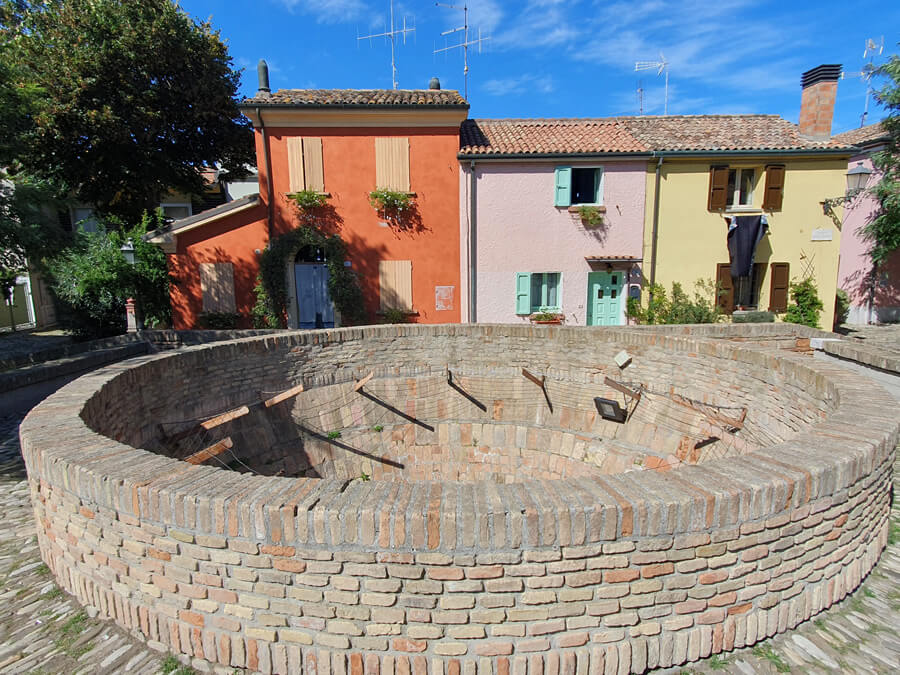
Around the centro storico you’ll find attractive lanes, appealing little shops and boutiques, and eateries. Murals and street art add colour to some of Cesenatico’s walls – check out the large painted scene by Walter Masotti celebrating the town and its maritime history in Piazzetta dell Erbe and the row of marine murals in Via Baldini.
Like much of the Adriatic coastline, Cesenatico spent time ruled by the Venetian Republic. In Cesenatico’s case, this was only for a couple of years in the early 16th century, but there’s a reminder of this by one of the bridges: twin columns in pink granite; the kind erected by Venice around its domains, usually topped by the winged Lion of St Mark.
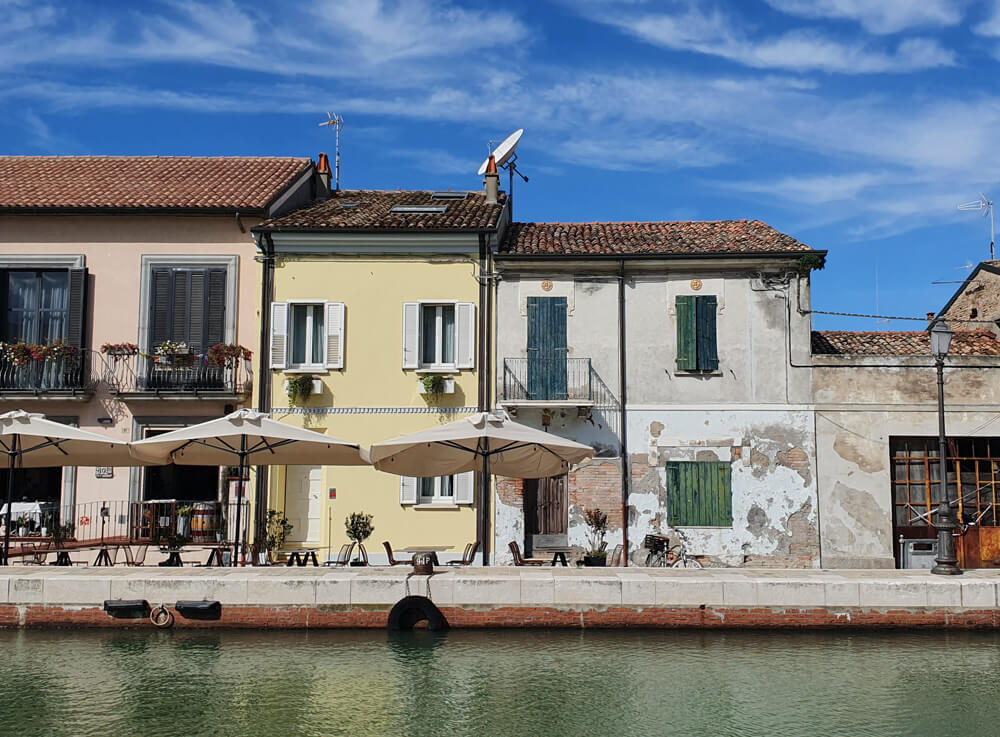
Historic sights are fewer in the modern beach settlement, but I became quite fascinated by the wild variety of architectural styles along the straight tree-lined avenues, including fine Art Nouveau Liberty-style villas. Cesenatico’s most incongruous landmark is its 35-storey skyscraper, the Grattacielo Marinella (or Grattacielo di Cesenatico). When construction was completed in 1958 this was Italy’s tallest building. Facing this beachfront tower across Piazza Andrea Costa is the palatial 1928 Grand Hotel Cesenatico. On the waterfront between these two contrasting buildings is a Ferris wheel (seasonal), the Ruota Panoramica, illuminated at night and offering wide coastal views in the daytime.
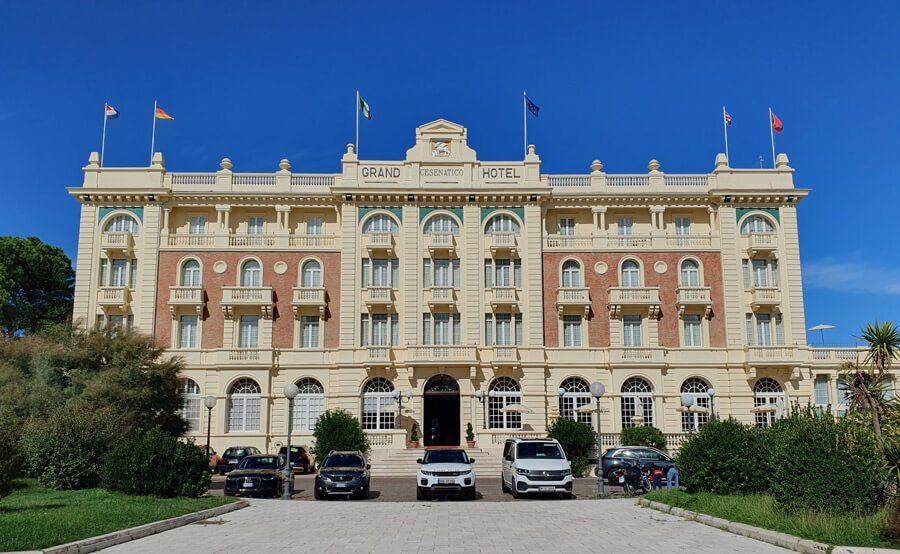
Visiting Cesenatico it’s impossible not to be aware of the tragic story of the local and international cycling legend Marco Pantani (1970-2004), celebrated as Il Pirata and much-loved throughout Italy. There’s a Pantani museum by the railway station, the Spazio Pantani, which is devoted to the cyclist and managed by his family. Here you can see memorabilia and jerseys from his career and some of his artworks. Tributes in the town include a monument with a statue of the Pirate in seafront Piazza Marconi, murals and a set of globe-shaped photographic memorials by the Grand Hotel. Since the year of his death a race in his memory has been held in Cesenatico, the Memorial Pantani.
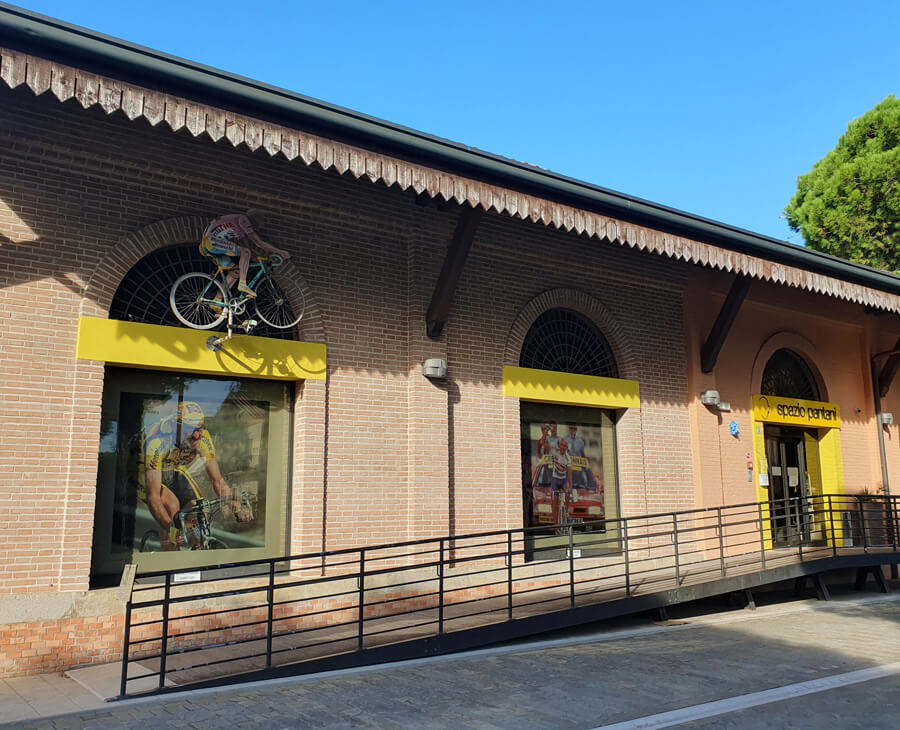
Cesenatico beaches
Cesenatico has a long wide beach of lovely fine sand. Like all Italian beach resorts, most of its length is divided between private beach establishments where you pay for a sunbed and parasol for a comfortable, civilised seaside experience. There are also stretches of free beach, however. Hotels may include beach sun-loungers in their room prices or offer special rates at an affiliated establishment.
Areas of free beach – spiaggia libera – which are open for public use are located at intervals along the seafront, and you can stroll along the water’s edge as far as you want. Free beaches can be found by the breakwater alongside the Porto Canale, in front of Piazza Andrea Costa and dotted along the beach. They’re indicated on a map available from the tourist office. I’d always recommend asking locally for beach recommendations, whether for free or paying beaches, to help you find the best options, which may vary according to wind, sea conditions or other variables.
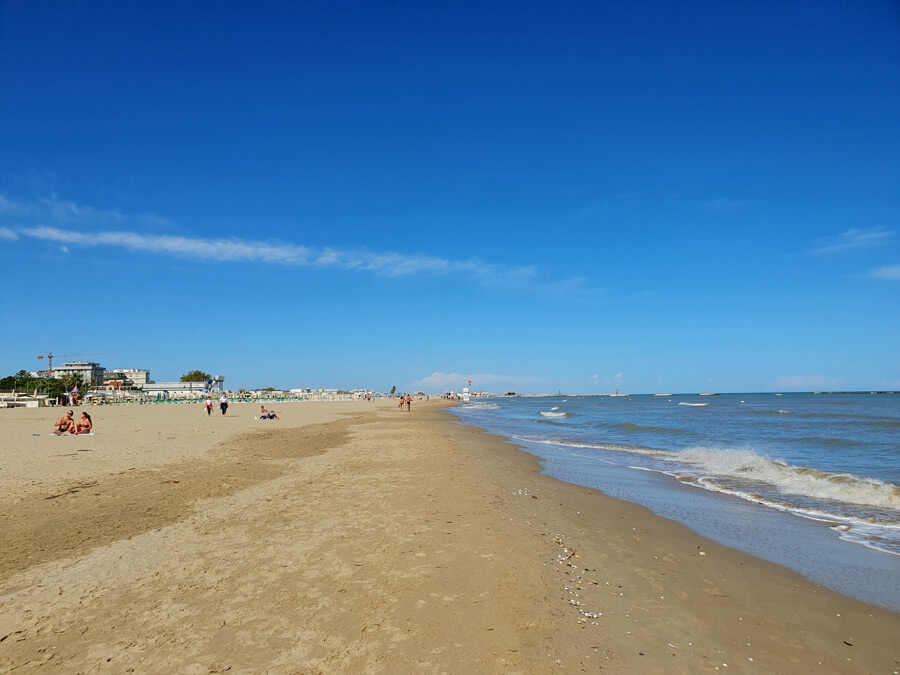
Eating and drinking
One of the best meals I ate that particular week in Emilia-Romagna was the slice of take-away pizza I bought from Pizzeria Materiaprima in Cesenatico’s Piazza Pisacane, and ate while hurrying to the railway station: seasonal autumn flavours provola cheese, succulent mushrooms and radicchio.
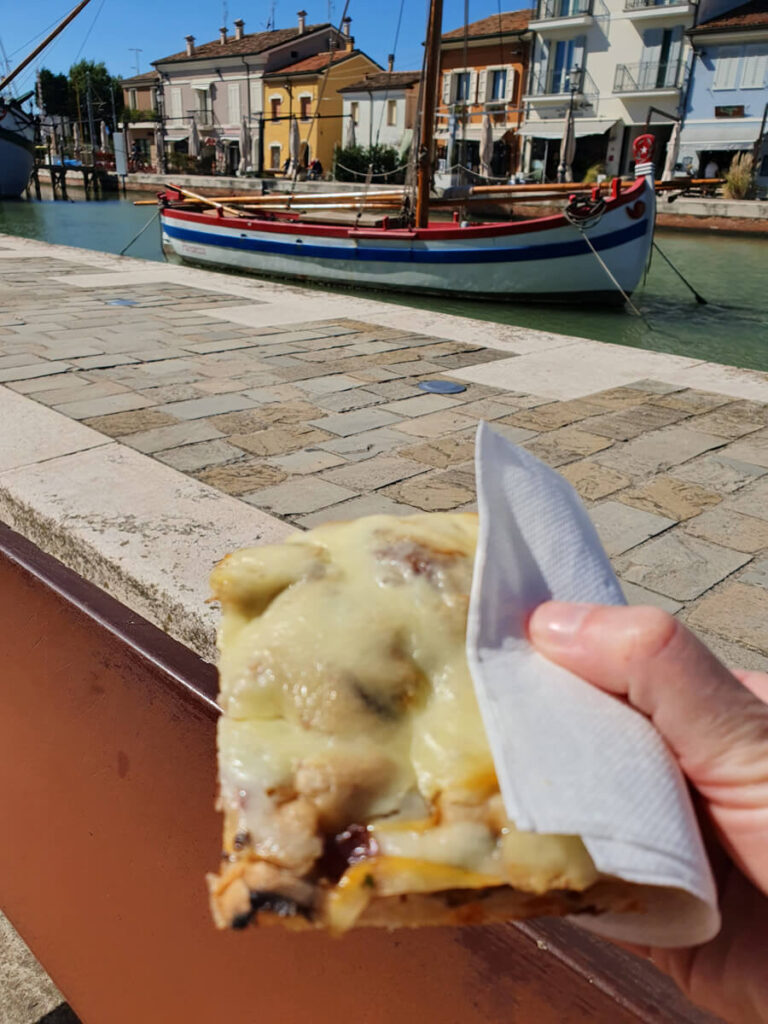
For those with more time to enjoy the bounty of this famously foodie region, there is a large choice of restaurants, cafés and bars along the length of the Porto Canale. More can be found down side-streets (including vegan/vegetarian Ciotolina in Piazza delle Erbe) and along the seaside strip. Whether you’re enjoying pasta, a piadina, a morning cappuccino or an aperitivo, you will almost certainly choose to while away part of your time in Cesenatico on the picturesque waterside. Choose which side of the canal you fancy – sunshine or shade? – pick a canalside table with a view, and sit back to enjoy the dolce vita and Italian small-town life at its best.
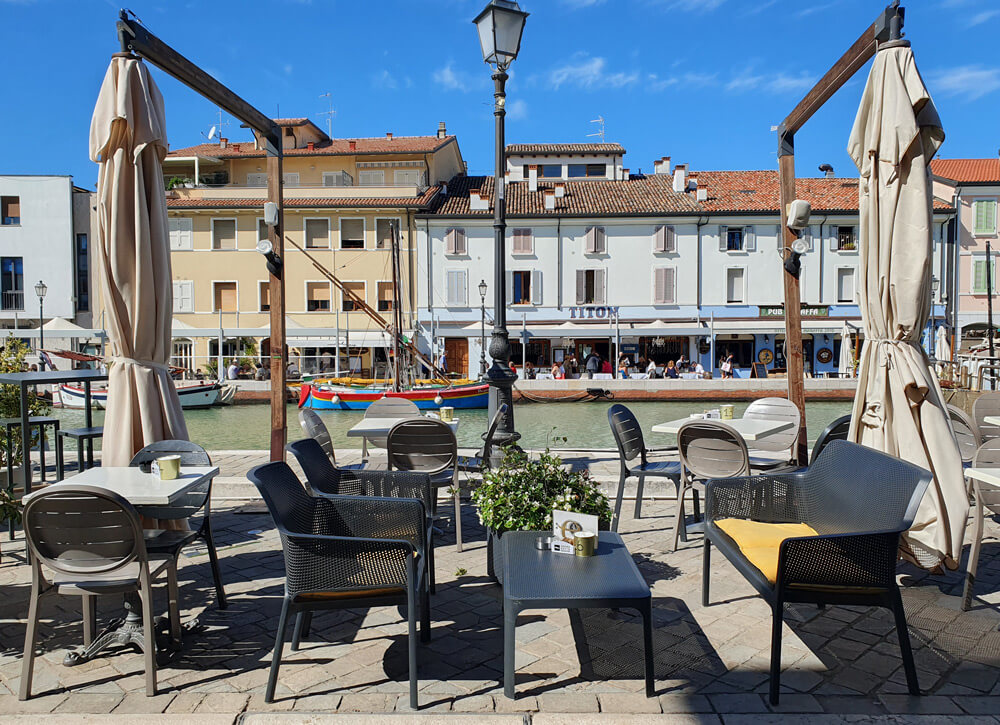
When to visit Cesenatico
As a popular seaside resort, Cesenatico is at its liveliest and busiest during the peak Italian summer holiday season in July and August. Visit during the weeks either side of this and you’re still likely to enjoy fine, warm weather and holiday services up and running without the same crowds. Note, though, that June in Italy can see the first heatwaves of the year, and September arrives with the risk of occasional storms. I visited in late September and had an enjoyable summery welcome, though the wind was up (red flags on the beach) and admittedly I was in Emilia-Romagna in a warm, dry week between two rainy spells.
Given the town’s charms extend beyond beach life, you could enjoy a relaxing break strolling along the Porto Canale at any time of year, though tourist businesses may close and the weather be less mild as winter approaches.
In December there is another reason to visit. The historic boats in the ‘floating section’ of the museum are dressed up with lights for an elaborate Christmas Nativity scene on water alongside a weekend Christmas market.
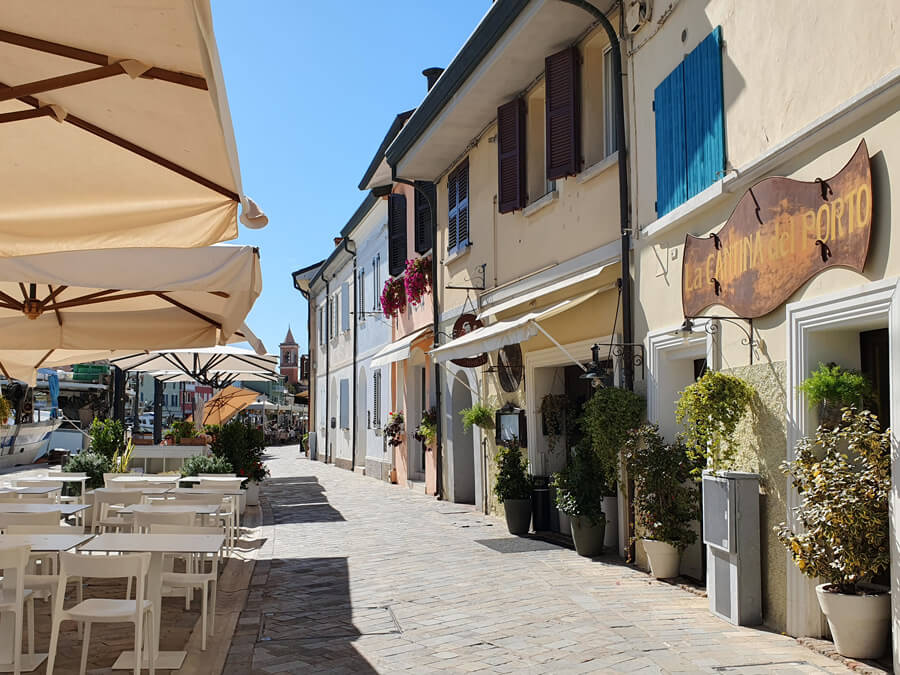
Where to stay in Cesenatico
- Find and book accommodation in Cesenatico – a wide range of places to stay, including hotels, B&BS and apartments.
Most visitors to Cesenatico will, of course, be there for its seaside appeal and will prefer to stay in the beach strip. The majority of the town’s hotels and places to stay are located here, with the historic centre a walk, bike, bus or taxi-ride away.
If you are staying outside the summer season, or are more a museum-and-culture visitor for whom the beach is just an attractive extra, I’d consider looking for accommodation in the historic centre, near to the Porto Canale. You won’t find big seaside hotels in the centro storico, but there are some very enticing B&Bs with glowing reviews (note that some don’t offer in-house breakfast). The Porto Canale area is the most convenient for train trips as the railway station is close by, so this location is ideal if you’re exploring further afield.
Accommodation links on these pages are my affiliate links. If you make a booking through these, Italy Heaven will earn a small amount of commission without you paying any extra. Thank you so much for your support in keeping the website online!
- Casina Le Conserve – a charming central B&B on picturesque Piazza delle Conserve
- Hotel Ambra – popular 3-star hotel near the beach
- Approdo29 Cesenatico – stay on the 29th floor of the skyscraper. An apartment rental for fans of high places and big views
- LaBotanica Casalounge – sleek modern aparthotel with its own beach establishment a short walk away, on the northern side of town
- La Finestra sul Porto – right on the picturesque port canal, this B&B is ideal for views and a passeggiata
- Maree Hotel – a welcoming hotel with excellent reviews, handy for the beach and waterpark
- More accommodation in Cesenatico
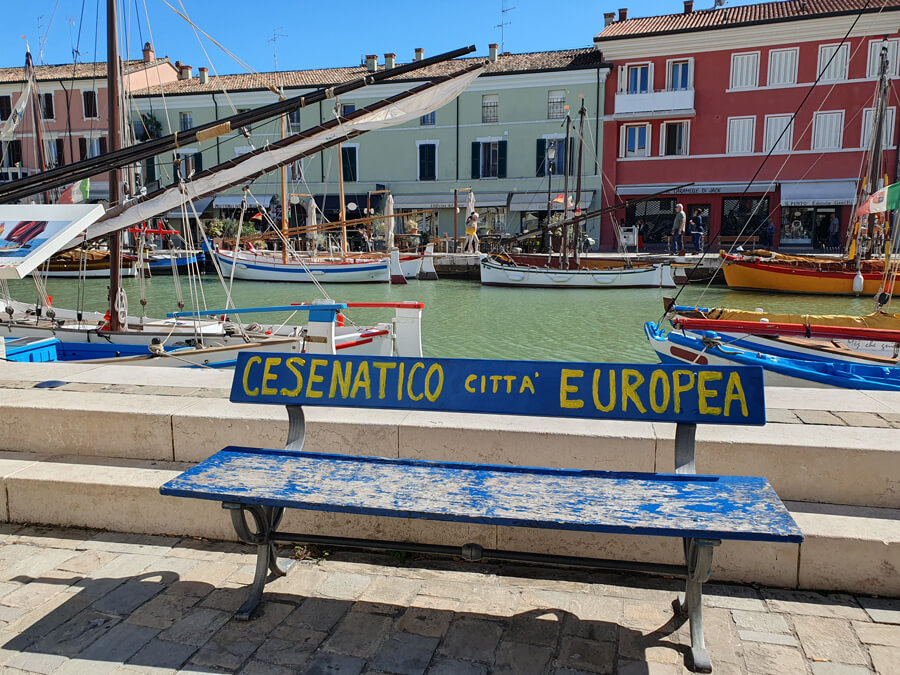
Visiting Cesenatico by public transport
Cesenatico by train
Cesenatico is on a railway line which runs between Rimini (a 26-minute journey away) and Ravenna (25 minutes), with some trains continuing on past Ravenna to Bologna. Regional trains on this route are a fairly comfortable and a cheap way to travel.
Airports
The most convenient airports for Cesenatico are Bologna and Rimini, although flights between Rimini and the UK are limited and seasonal. Forlì airport is also conveniently located, but at the time of writing has very limited international flights.
From Rimini Airport, take bus number 9 from the airport to the railway station, then a train to Cesenatico. From Bologna Airport you can take the Marconi Express monorail to Bologna Centrale station, then a ‘stopping’ regional train to Cesenatico via Ravenna (around 1 hour 40). If you’re staying near the sea and you have luggage, a taxi or local bus will be helpful for the last leg of your journey.
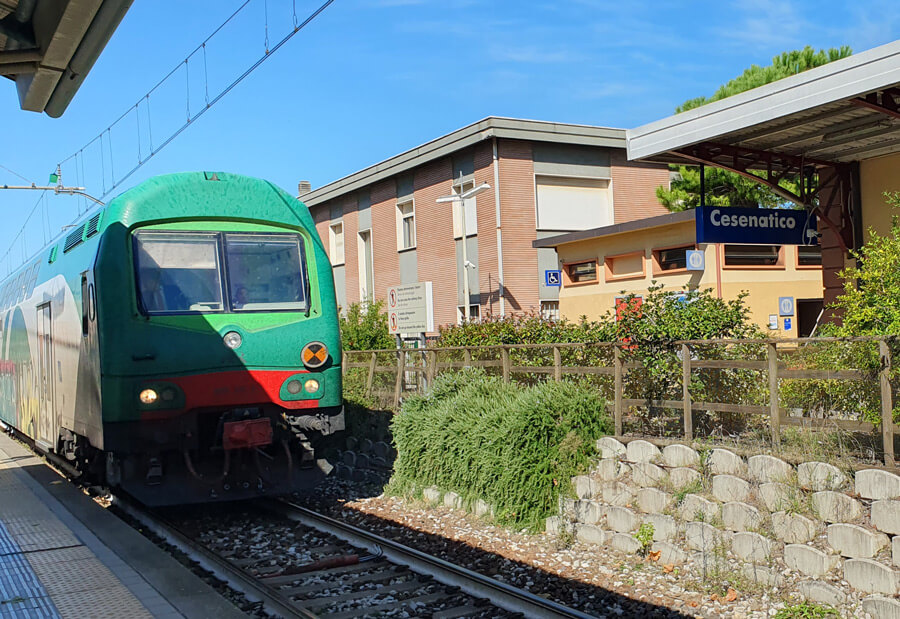
Arriving by rail
Arriving from Rimini, the train crosses the wide Cesenatico canal as it approaches the station, with a glimpse down the attractive waterway. Alighting at the station, head right to the canal then follow it down through the historic centre. The Museo della Marineria is just a few minutes from the station, on the first stretch of canal on the same side.
The Spazio Pantani museum is right next to the station, in part of the old station buildings, so can be fitted in conveniently at the start or end of a one-day visit.
While the historic centre is conveniently close to the railway, the seafront is about a mile from the station. As the first part of the walk to the sea is through the beautiful centro storico, I’d suggest making the journey on foot.
Arriving by bus
There are also a number of long-distance bus services connecting Cesenatico with other cities in the region and further afield. There’s also a firm offering a combined shuttle-and-chauffeur service from Bologna airport via Cesena. I’d suggest checking the local tourist board website for the latest links for these.
Getting around Cesenatico
Cesenatico is a fairly walkable destination. The nearest stretch of beach to the historic centre is only ten minutes beyond Piazza Ciceruacchio, walking down Viale Anita Garibaldi. I found Cesenatico’s seaside settlement catered well for pedestrians, with wide pavements and plenty of street crossings – a pleasant contrast to where I was staying in Rimini.
A good way to get around during a beach holiday in Cesenatico is by bicycle. Many hotels and B&Bs offer free bike rental for guests. There are also local buses, which may be useful, especially if you’re staying further along the coastal strip. These buses are operated by Start Romagna (timetables listed under Forlì-Cesena). I found local bus information well-integrated with Google Maps when I travelled in this region.
Excursions and day trips to and from Cesenatico
I visited Cesenatico as a tightly-scheduled half-day trip from Rimini, as I had other commitments in the afternoon. While it’s possible to see the highlights in this time frame, it would obviously be better to enjoy a full day pottering around the town and enjoying more than fifteen minutes on the beach. If you are staying here and taking your holiday at a leisurely pace with beach time, I think you could easily pass two or three days in Cesenatico without feeling much need to explore further. In a week’s holiday or longer, there would be time for a total immersion in Italian seaside life or for adding in excursions by train to see the mosaics of Ravenna or historic centre of Rimini.
If you like Cesenatico …
You will probably enjoy Caorle, further north in the Veneto region of Italy. Like Cesenatico, Caorle is a civilised family beach resort on the Adriatic with a welcoming atmosphere and a picturesque historic centre filled with colourful buildings and restaurants. Chioggia, at the southern end of the Venetian lagoon, shares a maritime history and canal scenery with Cesenatico, and also has a modern beach resort on its seaward side.
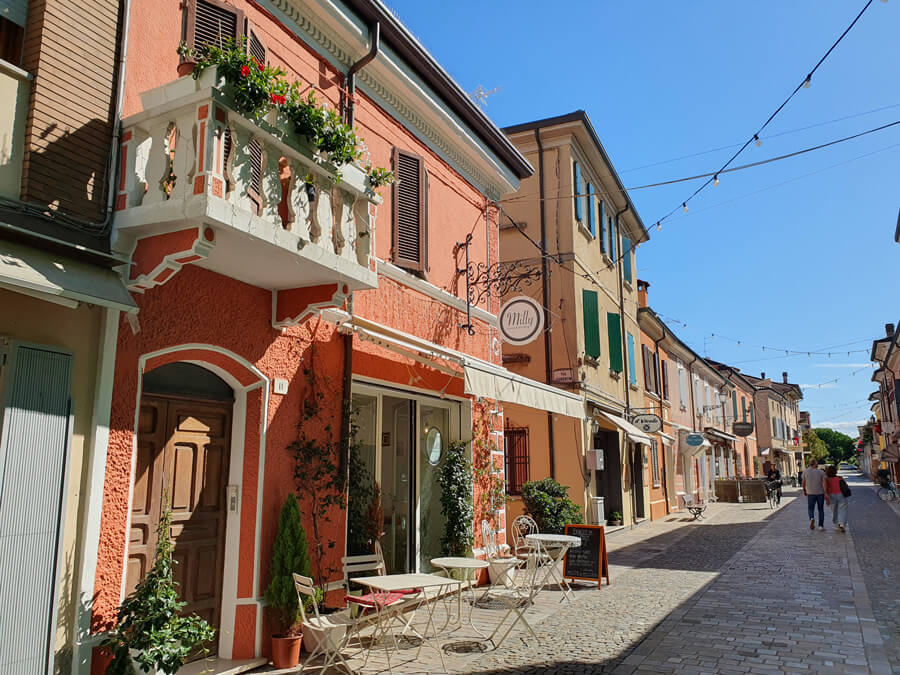
Emilia-Romagna destinations
Further reading
- Northern Italy: Emilia Romagna (Bradt Guides) – a good English-language guidebook about the region (Amazon.co.uk affiliate link). This may be helpful if you’re planning to tour beyond Cesenatico.
- Liberty-style villas – an itinerary (Emila-Romagna Turismo)
- Cesenatico Custodi dell’Arte – a Cesenatico audio-guide
- Tim Parks: The Hero’s Way, Walking with Garibaldi from Rome to Ravenna (Amazon.co.uk affiliate link)
- Cesenatico was bombed by the Allies in WW2, and later liberated by them (October 1944). If this period interests you, here are a few online sources with snippets of local wartime history:
- War reminiscences by Australian Flight Lieutenant Norm Gilham 454 RAAF Squadron, including a brief description and photo of a ‘peaceful retreat’ in Cesenatico. “A small and quiet little fishing village that should not have known the violence, of war; but like so many such places in the world at that time it had, and had been badly damaged”.
- People of Cesenatico, Italy : Returning to their homes over a temporary floating bridge | Imperial War Museums – a drawing by Edward Ardizzone
- Cesenatico bombing (International Bomber Command Centre Digital Archive)
- A description of the arrival of Allied troops in Cesenatico
- Supply Company – New Zealand in WW2, with accounts of the campaign in Italy and references to this area
- Photographs of German bunkers and beach defences
